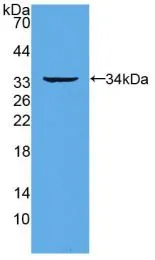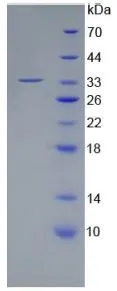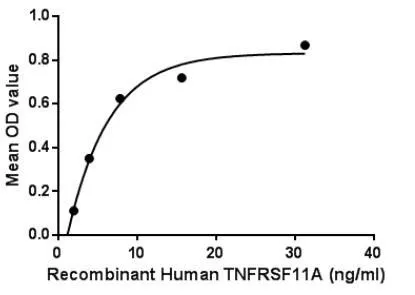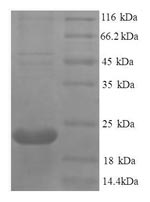
WB analysis of GTX00262-pro Human RANK protein.
Human RANK protein, His tag
GTX00262-PRO
ApplicationsFunctional Assay
Product group Proteins / Signaling Molecules
Protein IDQ9Y6Q6
Overview
- SupplierGeneTex
- Product NameHuman RANK protein, His tag
- Delivery Days Customer9
- Application Supplier NoteRANK tumor necrosis factor receptor superfamily member 11A protein (TNFRSF11A) also known as receptor Activator of Nuclear Factor kappa B (RANK) or TRANCE Receptoris a member of the tumor necrosis factor receptor (TNFR) molecular sub-family. TNFRSF11A is the receptor for RANK-Ligand (RANKL) and part of the RANK/RANKL/OPG signaling pathway that regulates osteoclast differentiation and activation. It is associated with bone remodeling and repair, immune cell function, lymph node development, thermal regulation, and mammary gland development. Besides, TNF Receptor Associated Factor 5 (TRAF5) has been identified as an interactor of TNFRSF11A, thus a binding ELISA assay was conducted to detect the interaction of recombinant human TNFRSF11A and recombinant human TRAF5. Briefly, TNFRSF11A were diluted serially in PBS, with 0.01% BSA (pH 7.4). Duplicate samples of 100 microl were then transferred to TRAF5-coated microtiter wells and incubated for 2h at 37C. Wells were washed with PBST and incubated for 1h with anti-TNFRSF11A pAb, then aspirated and washed 3 times. After incubation with HRP labelled secondary antibody, wells were aspirated and washed 3 times. With the addition of substrate solution, wells were incubated 15-25 minutes at 37C. Finally, add 50 microl stop solution to the wells and read at 450nm immediately. The binding activity of TNFRSF11A and TRAF5 was in a dose dependent manner.
- ApplicationsFunctional Assay
- CertificationResearch Use Only
- ConjugateUnconjugated
- Protein IDQ9Y6Q6
- Protein NameTumor necrosis factor receptor superfamily member 11A
- Scientific DescriptionThe protein encoded by this gene is a member of the TNF-receptor superfamily. This receptors can interact with various TRAF family proteins, through which this receptor induces the activation of NF-kappa B and MAPK8/JNK. This receptor and its ligand are important regulators of the interaction between T cells and dendritic cells. This receptor is also an essential mediator for osteoclast and lymph node development. Mutations at this locus have been associated with familial expansile osteolysis, autosomal recessive osteopetrosis, and Paget disease of bone. Alternatively spliced transcript variants have been described for this locus. [provided by RefSeq, Aug 2012]
- Storage Instruction-20°C or -80°C,2°C to 8°C
- UNSPSC12352202








